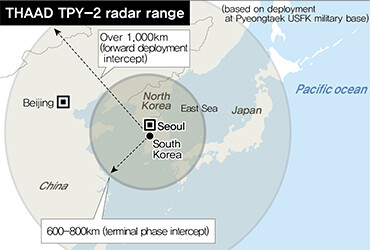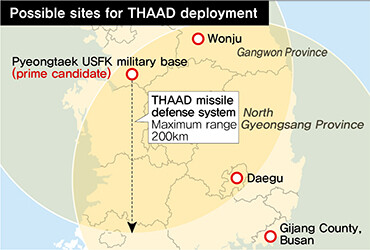hankyoreh
Links to other country sites 다른 나라 사이트 링크
THAAD deployment in Korea would likely lead to increased tensions in NE Asia

The controversy over deploying a Terminal High Altitude Area Defense (THAAD) system on the Korean Peninsula, which recently resurfaced in the wake of North Korea’s fourth nuclear test, is poised to make major waves in Northeast Asia.
At first glance, the controversy over THAAD, a US missile defense system, is similar to the kind of pot-stirring by the US and belated scrambling by South Korea seen in the past. This time, it has been the US press taking the lead, with the Wall Street Journal reporting on Jan. 28 that Washington and Seoul might hold final negotiations on THAAD deployment as early as next week or the week after. The report prompted an official denial from Ministry of National Defense Spokesperson Kim Min-seok - albeit with the proviso that “it would help South Korea’s security if THAAD were deployed with USFK [US Forces Korea].”
The situation this time is different from the past, particularly in its timing. The THAAD issue resurfaced at a delicate moment when frictions were becoming increasingly visible between South Korea and the US on one side, and China - which has objected to their single-minded focus on sanctions after the nuclear test - on the other. Analysts suggested the recent leaking of intelligence from the US and Japan about an imminent North Korean long-range rocket test may be their way of lending support for a possible THAAD deployment. It has also been argued that one aim of the US bringing the issue up again is to pressure China into going along with sanctions.
Another focus of the THAAD issue is on recent calls in South Korea for independent nuclear armament in response to the nuclear test. In addition to reaffirming its commitment to extended deterrence - the nuclear umbrella - the US may also have sensed the need for some alternative to appease South Korean proponents of nuclear armament, with THAAD offered up as an acceptable substitute.

But Seoul and Washington’s strategy of using THAAD to pressure Beijing runs a serious risk of backfiring. China’s strategy for the Korean Peninsula is based on on the potential threat of a confrontation with the US, where North Korea remains a crucial buffer. North Korea’s geopolitical worth is also poised to grow as trilateral security cooperation by South Korea, the US, and Japan increases in the nuclear test’s wake. The attempt by Seoul and Washington to use the THAAD controversy as a pressure tactic could have the effect of pushing North Korea and China closer together instead of driving them apart.
Another risk is a possible chill in relations between South Korea and China. The Global Times, an English-language daily under the auspices of the Chinese Communist Party newspaper the People’s Daily, has openly alluded to potential retaliation against South Korea for a USFK deployment of THAAD, warning that Seoul “needs to be ready to pay the price.” In truth, China is unlikely to pursue retaliation, as a souring of relations could drive South Korea farther into trilateral security cooperation with the US and Japan. But if any kind of chill did descend on bilateral ties, a severe blow to the heavily China-dependent South Korean economy would be inevitable.
One anticipated effect of a THAAD deployment on the peninsula would be to hasten the integration of South Korea’s indigenous Korean Air and Missile Defense system into that of the US. South Korea, the US, and Japan have already agreed on real-time sharing of North Korea-related nuclear and missile intelligence through their missile defense network by the end of the year. Adding a USFK THAAD system to that trilateral network would bring the integration of the three countries’ missile defense one step closer to completion.
The problem with the closer trilateral cooperation is that its use in the US containment strategy against China could have the side effect of encouraging closer security cooperation between North Korea and China - and even Russia. It’s an outcome that risks stirring up conflict and confrontation around the peninsula.
“If we bungle our response to the use of THAAD as a way of pressuring China, we risk getting drawn deeper into the US-led framework of security cooperation with Japan and being enlisted to help encircle China,” warned military critic Kim Jong-dae.
“We need to be having dialogue to find a solution that would give a role to all of the nations concerned, including China and Russia, rather than just focusing on forceful sanctions against North Korea,” Kim advised.
By Park Byong-su, senior staff reporter
Please direct questions or comments to [english@hani.co.kr]

Editorial・opinion
![[Column] Has Korea, too, crossed the Rubicon on China? [Column] Has Korea, too, crossed the Rubicon on China?](https://flexible.img.hani.co.kr/flexible/normal/500/300/imgdb/original/2024/0419/9317135153409185.jpg) [Column] Has Korea, too, crossed the Rubicon on China?
[Column] Has Korea, too, crossed the Rubicon on China?![[Correspondent’s column] In Japan’s alliance with US, echoes of its past alliances with UK [Correspondent’s column] In Japan’s alliance with US, echoes of its past alliances with UK](https://flexible.img.hani.co.kr/flexible/normal/500/300/imgdb/original/2024/0419/2317135166563519.jpg) [Correspondent’s column] In Japan’s alliance with US, echoes of its past alliances with UK
[Correspondent’s column] In Japan’s alliance with US, echoes of its past alliances with UK- [Editorial] Does Yoon think the Korean public is wrong?
- [Editorial] As it bolsters its alliance with US, Japan must be accountable for past
- [Guest essay] Amending the Constitution is Yoon’s key to leaving office in public’s good graces
- [Editorial] 10 years on, lessons of Sewol tragedy must never be forgotten
- [Column] A death blow to Korea’s prosecutor politics
- [Correspondent’s column] The US and the end of Japanese pacifism
- [Guest essay] How Korea turned its trainee doctors into monsters
- [Guest essay] As someone who helped forge Seoul-Moscow ties, their status today troubles me
Most viewed articles
- 1[Column] The clock is ticking for Korea’s first lady
- 2Hong Se-hwa, voice for tolerance whose memoir of exile touched a chord, dies at 76
- 3After 2 months of delayed, denied medical care, Koreans worry worst may be yet to come
- 4[Column] Has Korea, too, crossed the Rubicon on China?
- 5US overtakes China as Korea’s top export market, prompting trade sanction jitters
- 6[Correspondent’s column] In Japan’s alliance with US, echoes of its past alliances with UK
- 7All eyes on Xiaomi after it pulls off EV that Apple couldn’t
- 8Samsung barricades office as unionized workers strike for better conditions
- 9[Photo] Smile ambassador, you’re on camera
- 10[Correspondent’s column] The US and the end of Japanese pacifism